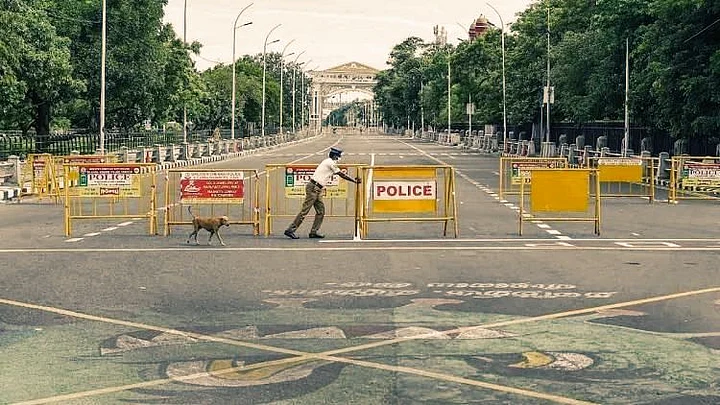Last week, the National Statistical Office released the Estimates of Gross Domestic Product (GDP) for the second quarter of the fiscal year 2021-22 (FY22), which showed that the Indian economy had expanded by 8.4 per cent as compared to the corresponding period in 2020-21. Coming after the economy had expanded by over 20 per cent in the first quarter of the current fiscal, can it be concluded that the 8 per cent second-quarter growth shows that the Indian economy is back on track after the pandemic-induced downturn?
Two Sets of Challenges for Government
The answer to this question lies in two sets of factors. One, whether the economy has got back to a sustained growth path, one that will enable it to reach the government’s aspirational target of making India a $5 trillion economy in the not-too-distant future. And two, the possible impacts of the headwinds, including the inflationary pressures, on the sustainability of the growth momentum.
An important fact that is often glossed over in the assessments of the post-pandemic GDP numbers is that the Indian economy was on a sharply declining growth path well before the impact of the COVID-19 pandemic was felt, which can be seen from Chart 1.
From the fourth quarter of 2017-18 to the fourth quarter of 2019-20, or during a span of nine quarters, India’s GDP growth had declined from 8.1 per cent to 3.0 per cent, which the Chart helps us to visualise. Due to this dual impact of the economic slowdown prior to the COVID-19 pandemic, followed by the pandemic itself, on the Indian economy, the government faces two sets of challenges during the recovery phase. One, it must pull the economy by its bootstraps, and two, it must continue to support the economy for sustaining its expansion using fiscal policy instruments, whose positive impulses can be felt quickly.
The latter challenge seems more formidable as can be seen from Chart 1. Although GDP growth has been registered in four consecutive quarters since the contraction in the previous fiscal, the growth momentum still seems to be missing. Not surprisingly, the level at which India’s GDP stood during the first quarter of FY22 (April-June 2021) was below the level it was in the third quarter of 2017-18, and this was 15 quarters back. Moreover, even after its uptick in the second quarter of the current fiscal, GDP was below the level it was in the fourth quarter of 2018-19, or 11 quarters back. It is, therefore, quite clear that the post-pandemic recovery that has been seen thus far remains unstable.
Private Final Consumption Has Dropped
This scenario is hardly surprising because the mainstay of GDP, namely, private final consumption expenditure (PFCE), has continued to remain depressed through this phase of recovery. In better times, PFCE has been well over 55 per cent of the GDP, but in the past several quarters, the share of PFCE has struggled to remain close to 55 per cent, and in the second quarter of FY22, it fell below this psychological mark. Further, in absolute terms, PFCE had declined continuously between the third quarter of 2018-19, before recovering in the second half of the previous financial year. However, recovery in PFCE was not sustained subsequently, which made its impact felt on the overall performance of the economy.
The current trends in PFCE reflect the continued depressed state of the labour market, which had suffered unprecedented shocks in the wake of the lockdown following the onset of the pandemic. According to the Centre for Monitoring Indian Economy, although the unemployment rate had decreased during the second quarter of FY22, the labour force participation rate had not risen very much from the depths to which it had fallen during the economic disruption caused by COVID-19.
Reliance on External Demand Can be Risky
Driving the Indian economy during the second quarter of FY22 was export growth, or in other words, foreign demand. As a share of GDP, exports were at the highest level during this quarter after they had touched similar levels in 2019-20. However, imports had bounced back even more, but mainly on account of rising commodity prices. Thus, India’s trade-to-GDP level had crossed the 50 per cent mark for the first time since 2013-14, and given the buoyancy that is currently being witnessed, there is every possibility that FY22 will end with trade playing an important growth trigger for the economy.
It must, however, be pointed out that reliance on external demand can have its own share of problems, as was experienced in the aftermath of the economic recession of 2008.
The global economy had recovered rather quickly, triggering export growth in many countries, including India, but it soon slumped back into an extended period of uncertainty. Therefore, India should be relying more on its large internal market to stimulate its economy and use external demand only as an additional lever.
One factor that India must be mindful of in the short run, especially when it is seeking to benefit from exports, is inflationary pressures. Over the past several months, the rate of inflation based on the Wholesale Price Index (WPI) has been quite high. Manufactured products had registered double-digit inflation over the past six months, which had increased to12 per cent in October 2021.
High rates of inflation can significantly erode India’s competitiveness in the global markets, and this would have to be checked to allow export demand to play a part in the country’s economic revival.
(Biswajit Dhar is Professor at Centre for Economic Studies and Planning, School of Social Sciences, Jawaharlal Nehru University. This is an opinion piece and the views expressed above are the author’s own. The Quint neither endorses nor is responsible for the same.)
